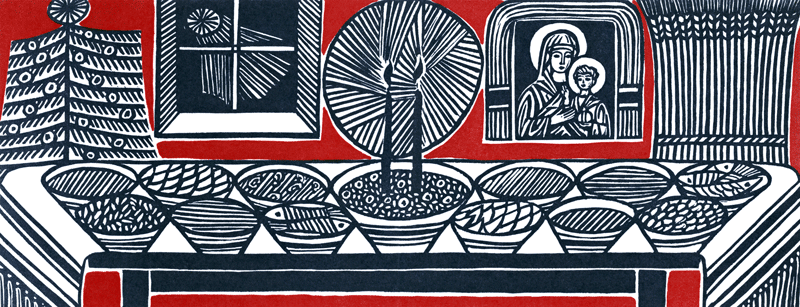
The celebration of Russian Christmas has been shaped by forces both astronomical and historical. Let’s look first at the calendar.
Most of Europe shifted to the Gregorian Calendar starting in 1582, but Russia retained the Julian Calendar. Peter the Great modernized the Julian calendar in 1699, making January 1, 1700 the beginning of the New Year, rather than September 1 (the traditional beginning of the Orthodox Liturgical Year), but discrepancies in the placement of Leap-Year days remained. Consequently, by the 19th century, Russia was 12 days out-of-sync with the West, and 13 days once the 20th-century turned.
When Bolshevism swept Russia in 1917, the Julian Calendar was abandoned quickly. Two weeks literally fell away from January 1918 as Lenin forced his country to “catch up” with Western dating. The Orthodox Church, however, remained steadfastly with their liturgical calendar (based on the Julian). Thus, December 25 in Eastern Christian practice today falls on January 7.
So that takes care of the astronomical issues of Russian Christmas. What about the historical forces? Well, for that story we return to the Bolshevik Revolution. It decimated Russian traditional life, including folk traditions. It obliterated the Orthodox Faith. Nearly all of the symbols and celebrations of Christianity were banned.
Communist ideology did offer “alternatives.” For Christmas, focus shifted to a ramped-up version of New Year’s. The Christmas tree (ёлька) became the New Year’s Tree. The fairy-tale figure of Father Frost (Дед Мороз) made a fine New Year’s Santa. The Snow Maiden (снегуричка), Father Frost’s counterpart, appeared as well. These images brought the flair needed for a spectacular Holiday. The government made oranges and other delicacies appear in the markets in late December. Christmas was soon forgotten.
Or was it? Since the fall of Communism in 1992, Russians have been free to revitalize their Christian traditions, and are doing so enthusiastically. The period of Communism is seen as a tragic hiatus in a millennium of Christian identity.
But, within the Eastern Christian practice, Christmas was, and remains, a modest celebration, tempered by the highly intimate and spiritual focus often found in Orthodoxy. The most public occasion is the Christmas Eve Vigil on January 6—what we in the West would call Midnight Mass. There is a festive mass on Christmas Day, too, but the Vigil is the highpoint, liturgically.
Preceding Vigil, however, will be a tender and highly symbolic “Holy Supper”—a special Christmas-Eve dinner (сочевник). The table is covered with linen and scattered with straw, reminding us of the swaddling clothes and the manger. The meal begins with prayers and concludes with prayers and singing of Christmas Hymns. The mother of the family may dispense a blessing of honey in the shape of the cross on each child’s forehead. Christmas Eve itself is within the fasting period, so the meal will consist of simple “Lenten foods” (no meat, dairy, or desserts).
Both Garlic and honey are important elements of the modest meal. Garlic (or bitter onions) is served as the first of twelve courses, reminding us that, until Christ’s coming, man faced only despair and bitterness, without the Promised Messiah. Twelve Courses should be served, representing, not surprisingly, the Twelve Tribes of Israel as well as the Twelve Disciples. The meal might look like this:
- Grated Garlic (or diced bitter onions)
- Mushroom soup (or Sauerkraut soup)
- Lenten bread
- Bowl of honey
- Baked cod
- Fresh Apricots, Oranges, Figs and Dates
- Nuts
- Stewed Kidney beans seasoned with shredded potatoes, garlic, salt and pepper
- Peas
- Parsley Potatoes
- Bobal’ki (small biscuits combined with sauerkraut or poppyseed with honey)
- Red Wine
You’ll find many variations, of course, particularly since you’ll find similar versions of this meal in Ukraine, Poland, and other Slavic countries.
You might be struck by the contrast between the Orthodox “Holy Supper” on January 6 (in preparation for Midnight Vigil) and our often hyper-charged Christmas Eve. To be fair, many Western families make a point of keeping Christmas Eve for family and church, refusing to be drawn into the spin of secular events. In this very Advent Calendar, we will post the tender Krippenspiel or Manger Play that is still staged in German Churches on Christmas Eve. But certainly few Westerners think of Christmas Eve as a period of fasting based on, essentially, Lenten foods.
This year, ask your children what they think the effect would be of having a Russian-style Christmas Eve supper. Remind them that Russians feast liberally on Christmas Day, much as they do on Easter (although nothing can top a Russian Easter-Day banquet). Consider pausing with your children at sundown on January 6 to give thanks for the religious freedom Russians have regained to celebrate their Christmas Eve. Perhaps incorporate parts of their traditional recipes into your own Christmas Eve supper. Let mom bless each child with the sign of the cross on the forehead in honey! It might become a cherished new family tradition.



